At the beginning of the 19th century the south and west of Georgia was still frontier territory. In 1806 a frontier fort was built called Fort Benjamin Hawkins, named after an Indian Scout sent to the area to trade. In 1822 the state of Georgia created Bibb County and in 1823 the site of Fort Benjamin Hawkins was designated the county seat. Many of the settlers in the area had come from North Carolina, so the new city was named Macon in honour of a North Carolina statesman called Nathaniel Macon. During the Civil War the city served as a hospital for wounded Confederates, a prison for Union soldiers, a manufacturing centre for Confederate weapons and for a year near the end of the war as temporary capital of the state. Surprisingly, Macon was spared the destruction that befell many cities in Georgia during the Civil War as General Sherman and his Union troops bypassed the city.
Woodruff House
Adjacent to the School of Law is a Greek Revival mansion built in 1836 for a railroad financier and banker. It was designed and built by Elam Alexander, a local building contractor, architect, business man and philanthropist. The house was once owned by Colonel Joseph Bond, one of the South's wealthiest cotton planters. In 1887 a 16th birthday ball was held in the house for Winnie Davis, daughter of former Confederate President Jefferson Davis. Originally known as Overlook Mansion, it was acquired by Mercer University in 1978 and renamed Woodruff House. The University uses the house for banquets, receptions and alumni events. It is open to the public only during the Cherry Blossom Festival in March, the run up to Christmas and for special events.
Cannonball House
Judge Asa Holt had this Greek Revival house built in 1853. The name Cannonball House comes from an incident on July 30, 1864 during the Battle of Dunlap Hill. Union forces under General George Stoneman fired on Macon and one shot struck the sidewalk in front of the house, then passed through the second column from the left, went on through the wall over a window and landed unexploded in the hall. Its course can be traced by the mended column, a patch in the plaster of the parlour, and a dent in the hall floor. The Cannonball House is owned and managed by the United Daughters of the Confederacy. The servants quarters and kitchen behind the house serve as the Macon Confederate Museum and have many interesting and rare relics of the era. Both house and museum are open to the public.
Hay House
General Sherman’s decision not to attack Macon has left it with a rich variety of antebellum (pre Civil War) houses. The Hay House (or Johnson-Felton-Hay House) was designed by the New York architect T. Thomas and Son for William B. Johnston who had become wealthy through investments in banking, railroads and public utilities. Johnston and his wife had visited Italy on their honeymoon and wanted to recreate the architecture that they had seen there. The Italian Renaissance Revival style house was completed in 1859. The house later passed to Johnston’s daughter Mary Ellen Felton and her husband who lived there and she owned it until she died in 1926. It was then bought by Parks Lee Hay, Senior, founder of the Banker's Health & Life Insurance Company. After the death of his wife in 1962 the Hay House became a private museum until in 1977 it was taken over by the The Georgia Trust for Historic Preservation. It is open for tours.
Washington Block, Mulberry Street
Although Macon is best known for its antebellum houses, the historic area centred on Mulberry and Cherry Streets has many fine old commercial buildings. The Washington Block, shown here, was built in 1857. During the Civil War the Macon Volunteers used the top floor as an armoury. After the Civil War, in the late nineteenth century, the Macon Bar Association maintained a mutual law library in the building.
Macon
Click on Minimap to navigate
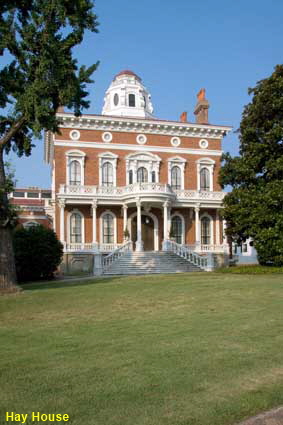
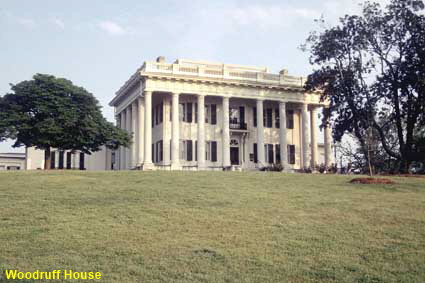
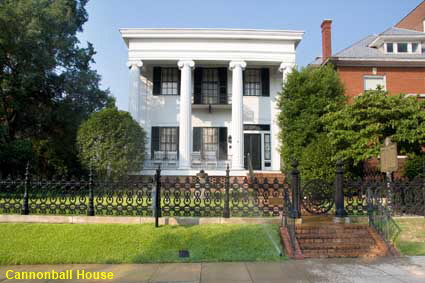
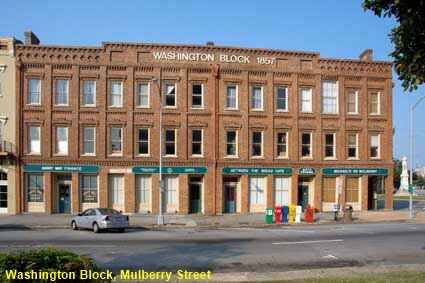
Walter F. George School of Law
The history of Mercer University goes back to 1833 when a boys' preparatory school named ‘Mercer Institute’ was founded in Penfield by Georgia Baptists. The school was named after Jesse Mercer, a prominent Baptist leader and the first chair of the Mercer Board of Trustees. Nowadays the University has 7,600 students; 11 schools & colleges and three major campuses in Macon, Atlanta and Savannah. The School of Law was founded in 1873, one of the oldest law schools in the United States and the second oldest of Mercer's schools & colleges. It is named after Walter F. George, a distinguished Mercer Law alumnus from the class of 1901. The Law School building is a partial replica of Independence Hall in Philadelphia sitting atop Coleman Hill overlooking downtown Macon.
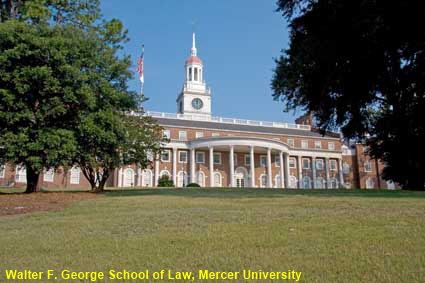


To move forwards or backwards through the Georgia trail click the arrows above, or select your next destination on the Minimap.
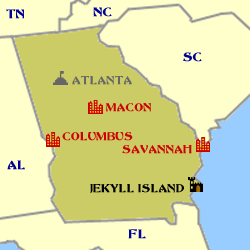
DLU101125

© Mike Elsden 1981 - 2025
The contents of this page may not be reproduced in full or in part without permission